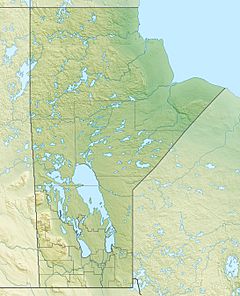Echimamish River facts for kids
Quick facts for kids Echimamish River |
|
|---|---|
|
Location of Echimamish River in Manitoba.
|
|
| Country | Canada |
| Province | Manitoba |
| Region | Northern Region |
| Physical characteristics | |
| Main source | Hayes River 54°22′54″N 96°32′05″W / 54.38167°N 96.53472°W |
| River mouth | Nelson River 54°19′39″N 97°26′29″W / 54.32750°N 97.44139°W |
| Length | 60 km (37 mi) |
The Echimamish River is a special kind of river in northern Manitoba, Canada. It's known as a river bifurcation. This means it flows in two different directions, connecting two separate river systems! In this case, it links the Hayes River and the Nelson River.
This river is about 60 kilometers (37 miles) long. It runs mostly from east to west. You can find it about 70 kilometers (43 miles) northeast of the top of Lake Winnipeg.
Contents
About the Echimamish River
The Echimamish River flows through very flat, swampy land. Because of this, its current is very slow, almost hard to notice. The water also looks dark because it flows through peat bogs. This is why it used to be called Blackwater Creek.
The river is quite shallow. Luckily, beaver ponds help make it deeper in places. These ponds make it easier for canoes to travel. Some people even say the river flows in two directions from a central beaver pond!
The Painted Stone Portage
Along the Echimamish River, there's a spot called the Painted Stone Portage. A "portage" is a place where you have to carry your boat over land. This one is very short, only about 20 paces (steps) long. It helps people get around a shallow and rocky part of the river. Besides beaver dams, this portage is one of the only tricky spots on the river.
A Historic Waterway
The Echimamish River was once a very important part of a travel route. It was used by voyageurs, who were early Canadian travelers and traders. They used this route to get from Hudson Bay to Lake Winnipeg.
Why This Route Was Important
Most of the Nelson River is hard to travel by boat. So, groups of canoes and larger boats called York boats would use the easier Hayes River. Then, they would switch to the Echimamish River. This allowed them to reach the upper part of the Nelson River and then Lake Winnipeg. The first European known to use this river was Joseph Smith in 1757.
A Canadian Heritage River
In 2006, a long historic route was given a special title. This route is about 600 kilometers (370 miles) long. It goes from York Factory to Norway House. It includes the Hayes River, the Echimamish River, and a section of the Nelson River. This entire route was named part of the Canadian Heritage Rivers System. This system protects rivers that are important for their history, culture, or natural beauty.



